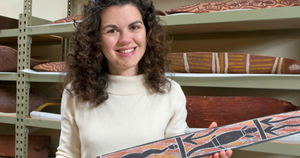- Details
The Australian Synchrotron’s X-ray Fluorescence Microscopy beamline shows the concentration and distribution of zinc in a cross-sectioned grain of rice with no treatment (left) and a grain of rice following soaking in water at 90˚C followed by steaming (right).
Efforts to address chronic malnutrition in billions of people have taken a step forward with Australian researchers defining processing conditions that boost the nutritional value of white rice – the staple food of more than a third of the world’s population.
While it is known parboiling grains before milling helps retain essential micronutrients, researchers from Charles Sturt University (CSU) and the NSW Department of Primary Industries (DPI) have used the Australian Synchrotron to compare parboiling techniques, showing in the LWT – Food Science and Technology journal that longer parboiling processes at higher temperatures cause more micronutrients to migrate from the outer bran layer into the starchy core of the grain.
Dr Peter Torley, Senior Lecturer Food Science and Technology at RMIT University and formerly of CSU, says the Australian Synchrotron’s X-ray Fluorescence Microscopy beamline has enabled researchers to accurately track the diffusion of nutrients at sub-micron resolution levels without damaging the rice grain’s internal structure.
‘Using the powerful and tightly-focused synchrotron beam meant we didn’t have to grind the rice to prepare our samples, which is necessary when using standard laboratory equipment, enabling more accurate interpretation as we could plot essential micronutrients to their precise locations within the grain, before and after parboiling.
‘Of the approaches in our experiments, soaking in water at 90˚C followed by steaming proved to be the most effective for retaining nutrients.’
White rice – prepared by drying and milling rice kernels, a process that strips the outer bran containing most of the nutrients, including iron, manganese, potassium and zinc – provides up to 80 per cent of the total caloric intake for people in some regions of the world, such as South-East Asia. Over two billion people, or 30 per cent of the world's population, suffer from iron deficiency with symptoms ranging from poor mental development in children to depressed immune function and anaemia.
NSW DPI researcher Mr Prakash Oli, lead author of the recently published paper and CSU PhD candidate, says the findings will have significant implications for rice production as researchers work to address micronutrient deficiency around the world.
‘Improving rice processing is one of two approaches we’re working on to combat widespread malnutrition; the second involves fine-tuning rice species to express more iron and other important nutritional minerals in the grain core during growth and during soaking, which can also reduce the glycaemic index (GI) of white rice.
‘Optimising rice processing is also important for farmers and industry as grain breakage during milling can cause crop value to plummet to as little as one per cent, something parboiling can help to avoid.’
Dr Laura Pallas, Rice Chemist at the NSW DPI, says changing global rice processing and eating habits is an enormous task, as there are deeply entrenched expectations across various cultures around consistency and flavour, and different approaches to parboiling ranging from those in small home farms to large industrial plants.
‘Rice is the closest thing we have to a global dish and it is gluten-free and a good source of complex carbohydrates.
‘If we can combine the higher micronutrient content of brown and coloured rice varieties with the light and fluffy texture of white rice, we could reach the holy grail: a rice version of “wonder white” bread that people, everywhere, really want to eat.’
This research was supported by the New South Wales Industry Synchrotron Access Scheme, supported in turn by the Office of the Chief Scientist NSW. The support of the NSW Department of Primary Industries in submitting the proposal to the New South Wales Industry Synchrotron Access Scheme is also acknowledged.
Media coverage
- ‘Aussies zap rice to find its vitals in search for a wonder white’, The Australian online, Thursday 28 April 2016.
- Details
Dr Rachel Popelka-Filcoff, an Australian Institute of Nuclear Science and Engineering (AINSE) Senior Research Fellow; image courtesy of Flinders University
The first non-destructive analysis of Australian Aboriginal ochre artefacts using advanced X-Ray technology has paved the way for more accurate cultural mapping and new insights into the origin and style of Indigenous artworks.
While European-style artworks have been analysed using X-Ray Fluorescence Microscopy (XFM) techniques, the new research kickstarts ‘hands off’ high-tech analysis of Aboriginal Australian art, beginning with a boomerang and a bark painting from the South Australian Museum's Australian Aboriginal Culture Collection.
Lead researcher Dr Rachel Popelka-Filcoff from Flinders University says the sensitive analysis of ochre-decorated objects using the XFM beamline at the Australian Synchrotron will help researchers better understand the cultural uses and techniques of Indigenous art and artefacts.
‘Relatively little is understood about the procurement, composition, and mixing of the natural mineral pigments that have been used in Aboriginal Australian objects.
‘This new method provides higher resolution information and an alternative to traditional destructive testing, while returning the object unharmed to the museum collection.’
In Indigenous communities, from human habitation of Australia to contemporary communities, ochres of many colours are used with wood and bark for cultural expression and exchange of ideas and knowledge.
Dr Popelka-Filcoff, an Australian Institute of Nuclear Science and Engineering (AINSE) Senior Research Fellow who has previously analysed more than 150 different kinds of ochre used around Australia, says high-resolution maps of pigment application generated at the Australian Synchrotron investigate the layering and application of ochre minerals without physically removing samples from the object.
‘Investigating the fine lines and dots in many Aboriginal objects, this technique has unparalleled resolution over other existing techniques, allowing further insights into the composition, application and layering of natural pigment on the micron scale.
‘The findings from across Australia will help to reconstruct ancient exchange routes, build on the existing provenance of Aboriginal art and objects, and help conservation and authentication studies.’
Dr David Paterson, Principal Scientist on the X-ray fluorescence microprobe at the Australian Synchrotron says the use of a highly sensitive and very efficient X-ray detector allows the radiation dose, particularly on these very old objects, to be as low as possible.
‘By using the powerful X-ray fluorescence microprobe for this research experts could gain more accurate data on the composition of the mineral pigments, much faster than other traditional X-ray methods, without damaging the ochre.’
The findings, also involving researchers from the University of South Australia, were published in Royal Society of Chemistry's Analyst journal and latest Emerging Investigators issue.
Media coverage:
- ‘Advanced x-ray analysis paints Indigenous artefacts in a new light’ on ABC radio’s ‘AM’, Friday 1 April 2016
- ‘Aboriginal ochre fingerprinting helping researchers trace ancient Indigenous trade routes’ on ABC news online, Thursday 31 March 2016
- Details
Researchers are one step closer to creating a universal, one-shot influenza vaccine following the discovery that T cells, essential in the immune response to influenza, can recognise and attack emerging, mutant strains of the virus.
An international research collaboration, led by University of Melbourne Associate Professor Katherine Kedzierska from the Peter Doherty Institute for Infection and Immunity and Dr Stephanie Gras from Monash University, used cutting edge single-cell technology, never before used in human influenza investigations, to hone in on human T cells one cell at a time to capture their response to the various strains.
The study, published in Proceedings of the National Academy of Sciences (PNAS) on Monday, found how the T cells reacted to new mutant strains of influenza as well as viruses they had previously been exposed to.
The team used the Australian Synchrotron to scrutinise the structure of the cells to identify how they recognise the mutant strains. They found that it was their flexibility and ability to adapt that enabled the T cells to essentially bully the new strains into submission.
Associate Professor Kedzierska said finding this piece of the puzzle was a major step forward on the path to creating a one-shot, T cell-mediated influenza vaccine for life-long immunity against the virus, which the World Health Organization estimates infects between three and five million people globally every year.
‘This is a game changer in flu research. Previous research has shown us T cells provide universal, protective immunity to influenza but, until now, we didn’t know why or how.
‘By using state-of-the-art procedures, this study enabled us to dissect the immune response to understand how this immunity occurs.’
Associate Professor Kedzierska said further research was necessary before a universal vaccine could be created.
‘Our past research has shown that only a seventh of the world’s population have the tissue make-up that provides universal immunity to influenza, the difference between a runny nose and being bed ridden.
‘Now we know what to look for, our challenge is to find these receptors in those with a different tissue composition and elicit a similar response.’
Dr Stephanie Gras said the precise, high-power X-Ray capability of the Macromolecular and Micro Crystallography (MX1 and MX2) beamlines was essential to the four-year study.
‘Use of the Australian Synchrotron was absolutely crucial to understanding these fine details of the immune response to influenza.’
Above image courtesy of ABC news
Media coverage:
- ‘Australian flu research raises hopes for universally effective vaccine’, on ABC’s PM, Wednesday 30 March 2016



